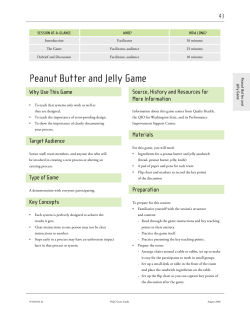
Document 354357
VISUAL AID FOR CREATING ENRICHMENT ITEMS Dhaval Vyas, MS and Kristin Mayfield, MS Centers for Disease Control and Prevention Introduction Enrichment devices are provided to laboratory animals to reduce abnormal behaviors and to promote species typical behaviors (e.g., foraging and nest building). With a diverse collection of species that require numerous enrichment options, a laboratory enrichment schedule can become difficult to manage. In order to promote the diversity of enrichment and to prevent the distribution of inappropriate enrichment items, animal care staff must be aware of the proper enrichment items to use for a particular species. Poster Designs Results Three posters were constructed and displayed for several weeks. A poster was created for macaques (Fig. 1), New World primates and small carnivores (Fig. 2). Unexpected deterioration of the color on the posters was observed one week following the display. The UV light from the ceiling bulbs caused fading on the glossy ink used to print the images. The quality of the images was tarnished and a reprinting of the posters using a different ink is in progress. APPROPRIATE DESTRUCTIBLE ITEM COMBINATIONS: MACAQUES FROZEN DESTRUCTI BLES PAPER BAG PAPER CUPS PAPER CUPS WAFFLE CONE TORTILLA HONEY DILUTED FRUIT JUICE APPLESAUCE PEANUT BUTTER YOGURT YOGURT HONEY APPLESAUCE PEANUT BUTTER HONEY & DRY FOOD PEANUT BUTTER & DRY FOOD HONEY & DRY FOOD HONEY In institutions where enrichment staff and animal care staff are differentiated , the use of appropriate and species-specific enrichment needs to be communicated effectively. A lack of understanding of how to properly construct an enrichment item can result in the improper and inefficient distribution of enrichment. The Environmental Enrichment Program at the Centers for Disease Control and Prevention designed posters that deal with the task of depicting the proper composition of enrichment items for a particular species. The enrichment posters display the correct enrichment and food item combinations by showing which foods belong with the appropriate enrichment objects. The array of different enrichment combinations is also presented. Animal care staff can use these visual aids to increase the diversity of enrichment items; thus, avoiding the distribution of inappropriate enrichment. YOGURT & DRY FOOD or FRUIT HONEY YOGURT DILUTED FRUIT JUICE & DRY FOOD or FRUIT PEANUT BUTTER APPLESAUCE & DRY FOOD or FRUIT YOGURT YOGURT PEANUT BUTTER & DRY FOOD YOGURT & DRY FOOD PEANUT BUTTER HONEY & DRY FOOD FRUIT PEANUT BUTTER & DRY FOOD OR YOGURT & DRY FOOD APPLESAUCE APPLESAUCE OR OR CENTERS for DISEASE CONTROL & PREVENTION ANIMAL RESOURCES BRANCH ENVIRONMENTAL ENRICHMENT OFFICE ATLANTA, GA Conclusions FIGURE 1. Poster depicting the appropriate enrichment combinations for macaques. “Destructible” choices are on top and the appropriate food items are below. APPROPRIATE ENRICHMENT COMBINATIONS: FOXES, SKUNKS & RACCOONS RUBBER FOOTBALL PAPER BAG Methods The posters were constructed using 3’ x 4.5’ poster paper. Images of enrichment objects and food items that are routinely used were collected from internet sources. The enrichment items were organized in a row and the appropriate food items that are allowed to be placed in the enrichment items were ordered under each item. Color coded arrows or brackets were used to further associate the food items with particular enrichment objects. If a food item could be paired with another food item (e.g., honey and mealworms), both items were placed in the same box. Written instructions for interpreting the poster were displayed beside the posters. Posters were displayed in rooms where food preparation occurred so that the staff could view the poster while creating enrichment items. A written survey is being proposed to determine whether the husbandry staff found the posters useful. Monthly enrichment sheets are also being reviewed to examine whether the diversity of enrichment items changed after the presentation of the posters. E-mail: cdcinfo@cdc.gov Web: www.cdc.gov The findings and conclusions in this report are those of the authors and do not necessarily represent the official position of the Centers for Disease Control and Prevention. Conversations with husbandry staff indicated that the posters did help them choose and construct enrichment items. The visual aspects of the posters made it easier to follow than reading a document. A few individuals indicated that the visual depiction of the enrichment and food item combinations helped in avoiding the use of redundant enrichment. An attempt to conduct a survey has been postponed until the printing of the new posters. A review of the enrichment sheets indicates that enrichment was distributed, but a relationship between the type of enrichment items and use of the poster cannot be determined at this time. CAT LITTER PAPER CUPS FROZEN CUBES BISCUIT BALL MOLECULE BALL RUBBER BONE HOLLOW BALL KONG TREAT DISPENSING BALL DOG BISCUIT PEANUT BUTTER DOG BISCUIT HONEY DOG BISCUIT HONEY SOFT TREATS SOFT TREATS The poster has potential to make the distribution of enrichment more efficient by visualizing the allowable enrichment combinations. According to the conversations with the animal care staff, the posters were better received than a written schedule because the images allowed the animal care staff to visualize the enrichment possibilities and gave them the freedom to choose varying types of enrichment. The posters clarify the proper combinations; thus, eliminating ambiguity regarding which food items belong in certain enrichment objects. PEANUT BUTTER PEANUT BUTTER SOFT TREATS DOG BISCUIT MEALWORMS HONEY PEANUT BUTTER CHICKEN BROTH Once new posters are constructed and presented to the husbandry staff, the survey will be used to assess the posters’ effectiveness. SOFT TREATS SOFT TREATS DOG BISCUIT PEANUT BUTTER SARDINES PEANUT BUTTER HONEY SOFT TREATS PEANUT BUTTER HONEY SOFT TREATS PEANUT BUTTER & MEALWORMS PEANUT BUTTER & MEALWORMS HONEY MEALWORMS HONEY & MEALWORMS HONEY & MEALWORMS HONEY & MEALWORMS With numerous species to manage, a visual aid for enrichment items serves as a useful tool for organizing the available enrichment options. Species-appropriate enrichment can be achieved when the staff are equipped with a visual guide that makes it easier to construct proper enrichment items. Acknowledgements CENTERS for DISEASE CONTROL & PREVENTION ANIMAL RESOURCES BRANCH ENVIRONMENTAL ENRICHMENT OFFICE ATLANTA, GA FIGURE 2. Poster depicting the appropriate enrichment combinations for foxes, skunks and raccoons. Enrichment choices are on top of the appropriate food items. We would like to thank Dr. Katherine Paul, Dr. Albert McCullen and Dr. Carolyn Black for their valuable input. I am in gratitude to the animal care staff and enrichment personnel for their constructive feedback. National Center for Emerging and Zoonotic Infectious Diseases Division of Scientific Resources CS217203-A
© Copyright 2025










